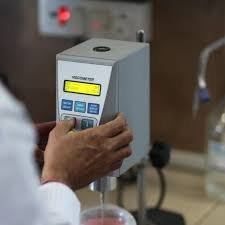“Techniques for Calibrating a Brookfield Viscometer for Precise Viscosity Measurements”

Calibration of Brookfield Viscometer: A Detailed Explanation
The Brookfield Viscometer is an instrument used to measure the viscosity of liquids and semi-viscous materials. It is essential to calibrate the viscometer to ensure the accuracy of measurements, which is particularly important in industries like pharmaceuticals, food processing, and chemical manufacturing, where viscosity plays a critical role in product quality and consistency.
What is Calibration?
Calibration is the process of adjusting an instrument to ensure its readings are accurate and consistent. For a Brookfield Viscometer, this means verifying that the instrument produces correct viscosity measurements by comparing it to a known standard or reference.
Why is Calibration Important?
-
Accuracy: Calibration ensures that the viscosity measurements provided by the instrument reflect true values, reducing potential errors in your processes or research.
-
Consistency: Regular calibration ensures that your results are consistent over time, even if there are minor changes in temperature, instrument wear, or other factors.
-
Compliance: Many industries require accurate measurements for regulatory compliance. Calibration helps meet industry standards and regulations.
-
Preventing Drift: Over time, instruments may experience drift, where their readings gradually become less accurate. Calibration prevents this drift from affecting results.
Steps Involved in Calibrating a Brookfield Viscometer
-
Preparation
-
Clean the Viscometer: Before calibration, ensure the viscometer is clean and free from residues from previous measurements. This prevents contamination and ensures accurate results.
-
Check the Spindle: Use the correct spindle for your sample type. Ensure it is free from damage or wear.
-
-
Choose Calibration Standards
-
Calibration typically uses known reference standards. For a Brookfield Viscometer, these standards are materials with a known viscosity.
-
Common calibration fluids include glycerin or specific calibration oils with precise viscosity values.
-
-
Temperature Control
-
Temperature affects viscosity measurements, so it’s essential to control the temperature of the calibration fluid. Many viscometers are equipped with a temperature control system or jacket to maintain the fluid’s temperature during calibration.
-
Standard calibration is usually performed at a specific temperature (e.g., 25°C or 40°C).
-
-
Set Up the Viscometer
-
Attach the appropriate spindle to the viscometer and ensure the device is properly mounted.
-
Select the desired speed or rotation rate for the viscometer. Speed can affect viscosity readings, so it’s essential to use the same speed for calibration and testing.
-
-
Measure the Viscosity of the Calibration Fluid
-
Immerse the spindle into the calibration fluid and measure the viscosity.
-
Record the reading shown on the viscometer display, which will be in centipoise (cP), the unit for viscosity.
-
-
Compare with Known Values
-
Compare the measured viscosity value with the known viscosity value of the calibration fluid at the selected temperature.
-
If the measured viscosity differs from the expected value, an adjustment is needed.
-
-
Adjustment (If Needed)
-
Adjustment of the Viscometer: If your measurements do not match the reference values, you may need to adjust the instrument. Most Brookfield Viscometers have an internal calibration mechanism to correct for discrepancies.
-
Manual Adjustments: Some models may require you to manually adjust the calibration settings based on the measured and expected viscosity values.
-
-
Repeat for Accuracy
-
To ensure precision, repeat the measurement process several times and confirm that the readings are consistent. If the device remains out of calibration, further troubleshooting or professional servicing may be needed.
-
-
Document the Calibration
-
Record all calibration details, including the date, viscosity readings, calibration fluid used, and any adjustments made. Documentation is essential for future reference and regulatory compliance.
-
Regular Calibration Schedule
To maintain accuracy, regular calibration is recommended. How often calibration is needed depends on:
-
The frequency of use.
-
The type of materials being measured.
-
The accuracy requirements of the measurements.
Calibration may be required monthly, quarterly, or even after a certain number of uses.
Types of Calibration (Single Point vs. Multi-point)
-
Single-point calibration: The simplest form of calibration, where you measure one known viscosity standard and compare the result with the reference value. It is suitable for general applications.
-
Multi-point calibration: This method uses several viscosity standards at different values to ensure a broader accuracy range. It is used for highly critical applications where precision is vital.
Troubleshooting Calibration Issues
If your Brookfield Viscometer is not giving accurate readings after calibration, consider the following checks:
-
Spindle Condition: Worn or damaged spindles can give incorrect readings.
-
Viscosity of the Sample: Ensure the sample’s viscosity is within the measurement range of the viscometer.
-
Air Bubbles: Ensure no air bubbles are trapped in the sample, as this can cause erroneous readings.
-
Temperature Fluctuations: Ensure the temperature is stable during calibration, as temperature variations can significantly affect viscosity.
Conclusion
Calibrating your Brookfield Viscometer is essential for maintaining measurement accuracy and ensuring reliable viscosity readings. Following a systematic calibration procedure, using proper standards, and ensuring a controlled environment are key to achieving consistent and precise results. Regular calibration, along with proper maintenance and troubleshooting, ensures that your viscometer continues to perform optimally in your quality control or research processes.
🎓 Discover one of the best Quality Assurance courses available — click below to explore the course that’s shaping future QA skills.

